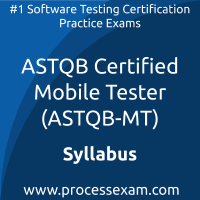 To achieve the professional designation of ASTQB Certified Mobile Tester from the ASTQB, candidates must clear the ASTQB-MT Exam with the minimum cut-off score. For those who wish to pass the ASTQB-MT certification exam with good percentage, please take a look at the following reference document detailing what should be included in ASTQB Mobile Tester Exam preparation.
To achieve the professional designation of ASTQB Certified Mobile Tester from the ASTQB, candidates must clear the ASTQB-MT Exam with the minimum cut-off score. For those who wish to pass the ASTQB-MT certification exam with good percentage, please take a look at the following reference document detailing what should be included in ASTQB Mobile Tester Exam preparation.
The ASTQB-MT Exam Summary, Body of Knowledge (BOK), Sample Question Bank and Practice Exam provide the basis for the real ASTQB Certified Mobile Tester (ASTQB-MT) exam. We have designed these resources to help you get ready to take ASTQB Certified Mobile Tester (ASTQB-MT) exam. If you have made the decision to become a certified professional, we suggest you take authorized training and prepare with our online premium ASTQB Mobile Tester Practice Exam to achieve the best result.
ASTQB-MT Exam Summary:
| Exam Name | ASTQB Certified Mobile Tester |
| Exam Code | ASTQB-MT |
| Exam Fee | USD $199 |
| Exam Duration | 60 Minutes |
| Number of Questions | 40 |
| Passing Score | 65% |
| Format | Multiple Choice Questions |
| Schedule Exam | ATSQA |
| Sample Questions | ASTQB-MT Exam Sample Questions and Answers |
| Practice Exam | ASTQB Certified Mobile Tester (ASTQB-MT) Practice Test |
ASTQB Mobile Tester Syllabus Topics:
| Domain | Details |
Introduction to Mobile Testing - 75 mins. |
|
| Expectations from Mobile Users | - Explain the expectations for a mobile application user and how this affects test prioritization |
| Challenges for Testers |
- Explain the challenges testers encounter in mobile application testing and how the environments and skills must change to address those challenges - Summarize the different types of mobile applications |
| Equipment Requirements | - Explain how equivalence partitioning can be used to select devices for testing |
| Lifecycle Models | - Describe how some software development lifecycle models are more appropriate for mobile applications |
Test Planning and Design - 60 mins. |
|
| Identify Functions and Attributes | - Explain why use cases are a good source of testing requirements for mobile applications |
| Identify and Assess Risks | - Describe different approaches to risk analysis |
| Determine Coverage Goals | - Explain how coverage goals will influence the level and type of testing to be conducted |
| Identify Test Conditions and Set Scope | - Describe how test analysts should take the device and application into consideration when creating test conditions |
Quality Characteristics for Mobile Testing - 290 mins. |
|
| Functional Testing |
- For a given mobile testing project apply the appropriate test design techniques - Recall the purpose of testing for the correctness of an application - Explain the important considerations for planning security testing for a mobile application - Summarize the concepts of perspectives and personas for use in mobile application testing - Summarize how device differences may affect testing - Explain the use of Teststorming for deriving test conditions |
| Non-Functional Testing |
- Create a test approach that would achieve stated performance testing goals - Recall aspects of the application that should be tested during performance testing - Explain why real devices are needed when simulators are used for testing - For a given mobile testing project, select the appropriate criteria to be verified with usability testing - Explain the challenges for portability and reliability testing mobile applications |
Environments and Tools - 285 mins. |
|
| Tools |
- Recall the expected capabilities for mobile application testing tools - Explain the use of generic tools in testing mobile applications |
| Environments and Protocols | - Recall the sources of data for a mobile application |
| Specific Application-Based Environment Considerations | - Explain the differences between browser-based and native device applications |
| Real Devices, Simulators, Emulators and the Cloud |
- Explain why testing is not conducted entirely on real devices - For a given mobile testing project, determine how and when to use simulators/emulators during testing - Recall how to verify the reliability of a simulator/emulator - For a given mobile testing project, determine how and when to use cloud-based testing |
| Performance Test Tools and Support |
- Explain how the cloud can be used to support performance testing - Explain the types of data a performance tool needs to be able to create and track |
Future-Proofing - 135 mins. |
|
| Expect Rapid Growth |
- Recall ways in which the mobile application and device market will expand - Recall areas in which user expectations will increase |
| Build for Change |
- Summarize the considerations for building a flexible testing framework - Analyze a given mobile testing project and determine the appropriate activities to reduce maintenance costs while enabling wide product adoption |
| Plan for the Future | - Explain how lifecycle models are likely to change and how this will affect testing |
| Anticipating the Future | - Recall the ways in which testers will need to adapt |
